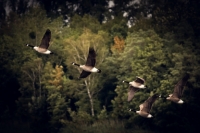Most birds are nocturnal migrants! Birds use the moon and stars to help guide them south. Nighttime also aids safety from daytime predators. Warblers, orioles, and vireos, for example, are nocturnal migrators that use the night's stable atmosphere and dark cover to head south. Cold nights keep birds from overheating as they make the journey to warmer climates. Birds that are stronger fliers such as hawks, pelicans, and falcons will fly south during the day.
Very little is known about how birds navigate urbanized landscapes during nocturnal migration. Stopover habitat loss, disrupted navigation from light pollution, and collisions with buildings and wind turbines are some dangers birds face while migrating. Scientists researching nocturnal bird migration will set up radars and microphones to track birds as they migrate south. Nocturnal migrators vocalize and make "night flight calls" that are not the complex melodious mating calls of spring. The calls are barely heard by humans and include chirps, buzzes, and tweets. Researchers believe that birds use these calls to communicate with each other. Making collective navigational decisions and communicating perils during the long journey are crucial to the bird's survival. Other research has found that birds that use flight calls during nocturnal migration tend to collide with buildings. Acoustic monitoring and radar tracking can help researchers aid urban developers in planning areas where birds can rest and avoid danger during movements. This increases migration success rates and species conservation.
There are a few things we can do to help nocturnal navigators, and one is to turn off lights at night to reduce confusing light pollution. Some cities have utilized this idea and have full city blackouts during peak migration times. Another idea that can help is treating your windows to prevent window collisions. The American Bird Conservancy has a great guide to help you get started on preventing window collisions. Fall migration is a great time to begin birding as birds will most likely stop by visiting backyards and local parks. It is a great time to reflect on what we can do to ensure our feathered friends' survival as they embark on their flights.
This blog is written by Elizabeth Gamillo, UEC Science Communication Intern.





